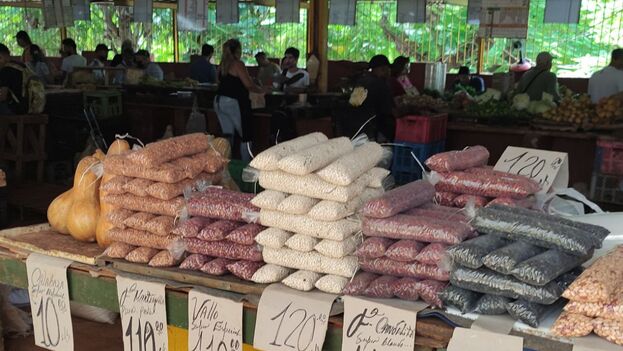
![]() 14ymedio, Havana, 9 January 2023 — The increase in food prices continues to push inflation in Cuba and accounts for 70% of the increase in the consumer price index last November. Restaurants and hotels (14%), which include breakfast, snacks and meals consumed outside the home, and transportation (5.5%) are the three sectors that contributed most to the variation that month, according to data published on Friday by the National Statistics and Information Office (ONEI).
14ymedio, Havana, 9 January 2023 — The increase in food prices continues to push inflation in Cuba and accounts for 70% of the increase in the consumer price index last November. Restaurants and hotels (14%), which include breakfast, snacks and meals consumed outside the home, and transportation (5.5%) are the three sectors that contributed most to the variation that month, according to data published on Friday by the National Statistics and Information Office (ONEI).
November marked the third largest increase in the cost of food in the last 16 months, 6.2% relative to October as economist Pedro Monreal explains on Twitter. The Cuban expert highlighted that, without access to the data from December, he estimates the Island will end the year with an inflation rate above 40%, “close to the 46% estimated by the Economic Intelligence Unit (EIU). It would be a very high inflation rate with a ruinous effect on purchasing power,” he adds.
The increase in Consumer Price Index (CPI) this month was 4.1%, very similar to the previous month (4.2%), but the cumulative rate for the year is already at 34.05% and is over 40% when compared to November of 2021, a year which was even worse — despite last year’s catastrophic data — and ended with an official annual inflation rate of 70%. This year, analysts estimate that the real increase in prices in the informal market, which moves the Island’s real economy, was 740%.
With regard to food, which determines the inflation rate according to the authorities themselves, the prices increased 54.22% relative to October and 62.83% compared to November 2021, indicative of the untenable daily situation for millions of Cubans. Although pork prices continue to increase and have increased by more than 9% compared to last month, coffee heads the list with an increase of 11%. Black beans, another staple of the national diet, is second on the list with a cost increase of 10.5%. The prices of snacks and ham are also increasing, by more than 8%, but that of tomatoes has fallen by 2.4.%, a product for which the market price has been capped in several provinces, with uneven results.
In the hotel and restaurant sector, prices are increasing faster in the latter; of note are increases in the price of snacks (8.8%), prepared, to-go foods (5.7%) and breakfast and beverages, with an increase of 5.5% for each. In the case of transportation, another basic need of daily life for Cubans, it experienced an increase of 1.04%, most noticeable in long distance taxis (6.2%), auto repairs (4.4%) and other long distance transportation (4%). In the case of urban transportation, the increase is not small, with an increase of 3.5% compared with October.
The remaining areas analyzed to determine how the CPI behaved also increased in November (none decreased compared to the previous month), although their weight in the calculations is lower. Goods and services (1.67%) and Furniture and Home Goods (1.2%) are, in that order, the sectors with increases greater than 1%. All other sectors, including education, health, communications, recreation and home services, were below 1%.
However, if we observe the year-to-year variation, we can observe rapid increases in the price of activities, such as leisure (61.2% compared to November 2021) or alcoholic beverages and tobacco, 26.75% higher than the previous year.
The numbers show that the lauded strategies, in place since 2021, to improve agricultural production do not go beyond words and have no effect. The markets continue to experience shortages and prices increase, even without taking into consideration the asking price for products on the parallel market.
In this context, the Cuban government has been forced to continue turning to its northern enemy to obtain the small amount of chicken people fight over. In November there was a spectacular increase in the amount and price of this U.S. product in Cuba, at a total cost of $32.06 million. This was a 56% increase in value and a 70% increase in tons compared to the previous month.
Cuba purchased 27,136.7 tons of poultry from the neighboring country, compared to 15,980 in October and 25,100 in September. Nonetheless, the record for highest imports were in the months of February 2022 and December 2021 when they surpassed 30,000 tons. However, with the current price increases, the costs are much higher. The price for a kilogram of chicken declined slightly in November compared to October, when it reached an historic record of $1.29, and sold for $1.18, though the total expenditures for Cuba were higher because the total amount imported was greater.
“Even without December data, 2022 is already the second best year (after 2021) for U.S. chicken exports to Cuba, both in value and in tons. It is one of the best case studies on the ineffective agricultural policies in Cuba,” stated Monreal.
Translated by: Silvia Suárez
____________
COLLABORATE WITH OUR WORK: The 14ymedio team is committed to practicing serious journalism that reflects Cuba’s reality in all its depth. Thank you for joining us on this long journey. We invite you to continue supporting us by becoming a member of 14ymedio now. Together we can continue transforming journalism in Cuba.
